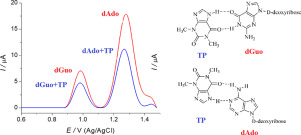Bioelectrochemistry ( IF 4.8 ) Pub Date : 2018-05-03 , DOI: 10.1016/j.bioelechem.2018.05.004 Katarína Nemčeková , Ján Labuda , Viktor Milata , Jana Blaškovičová , Jozef Sochr

|
The understanding of DNA-drug interaction mechanism is among the important aspects of biological studies for drug design, discovery and pharmaceutical development processes. Published rather detailed FTIR and UV–visible spectroscopic studies on the interactions of theophylline, theobromine and caffeine with calf thymus DNA have shown effective binding of these methylxanthine derivatives to DNA and RNA involving H-bonds. However, to our knowledge, there is no such investigation using electrochemical approach. As a novelty of the study, in this paper the bioelectrochemical approach has been chosen for the investigation of an interaction of low molecular salmon sperm dsDNA, ssDNA and mononucleotides with theophylline (TP) in aqueous phosphate buffered medium using DNA-based electrochemical biosensors and biosensing in solution phase. Exploitation of the electrochemical approach via changes in square wave voltammetric responses of deoxyguanosine (dGuo) and deoxyadenosine (dAdo) provided a new indication on preferential association of TP with dGuo in the case of double helical dsDNA structure which was not reported previously. Moreover, an attachment of TP molecules outside DNA was found in the presence of high concentration of 3.3 × 10−4 M TP in solution which diminishes the electron transfer and leads to the difficulties in quantitative evaluation of the TP and dGuo voltammetric responses. The changes in UV–vis and FTIR spectra obtained in the same medium confirmed the association interaction of TP with both nucleobases. Utilizing the model and the published energies of hydrogen bonding stabilization, the formation of a DNA-TP complex was predicted through the intermolecular H-bonds between TP and the NH-CO moiety of guanine and the N-NH2 moiety of adenine.
中文翻译:

使用电化学生物传感器和生物传感研究DNA和单核苷酸与茶碱的相互作用
对DNA-药物相互作用机制的理解是药物设计,发现和药物开发过程生物学研究的重要方面之一。关于茶碱,可可碱和咖啡因与小牛胸腺DNA相互作用的已发表的相当详尽的FTIR和紫外可见光谱研究表明,这些甲基黄嘌呤衍生物与涉及H键的DNA和RNA有效结合。然而,据我们所知,尚无使用电化学方法进行的此类研究。作为这项研究的新颖性,本文选择了生物电化学方法,用于使用基于DNA的电化学生物传感器和生物传感来研究低分子鲑鱼精子dsDNA,ssDNA和单核苷酸与茶碱(TP)在磷酸盐水溶液中的相互作用。在解决阶段。通过改变脱氧鸟苷(dGuo)和脱氧腺苷(dAdo)的方波伏安法响应来开发电化学方法,为双螺旋dsDNA结构中TP与dGuo的优先结合提供了新的指示,这是以前没有报道过的。此外,在3.3×10的高浓度存在下,发现了TP分子在DNA外部的附着。 溶液中的-4 M TP会减少电子转移,并导致难以定量评估TP和dGuo伏安响应。在同一培养基中获得的紫外可见光谱和傅立叶变换红外光谱的变化证实了TP与两个核碱基的缔合相互作用。利用该模型和已公开的氢键稳定能量,通过TP与鸟嘌呤的NH-CO部分和腺嘌呤的N-NH 2部分之间的分子间H键,预测了DNA-TP复合物的形成。











































 京公网安备 11010802027423号
京公网安备 11010802027423号